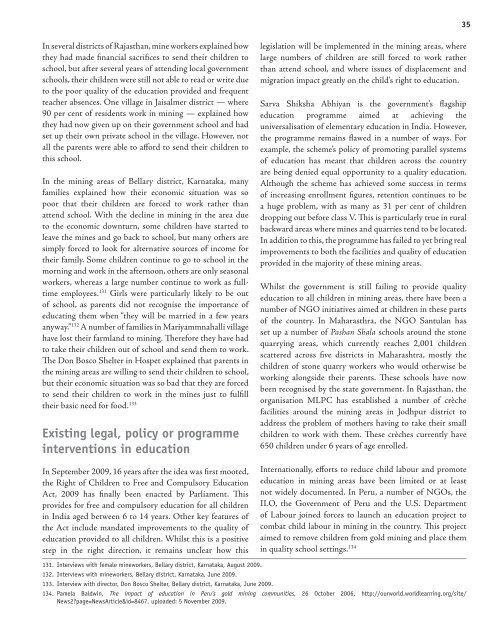Children - Terre des Hommes
Children - Terre des Hommes
Children - Terre des Hommes
Create successful ePaper yourself
Turn your PDF publications into a flip-book with our unique Google optimized e-Paper software.
35<br />
In several districts of Rajasthan, mine workers explained how<br />
they had made financial sacrifices to send their children to<br />
school, but after several years of attending local government<br />
schools, their children were still not able to read or write due<br />
to the poor quality of the education provided and frequent<br />
teacher absences. One village in Jaisalmer district — where<br />
<br />
they had now given up on their government school and had<br />
set up their own private school in the village. However, not<br />
all the parents were able to afford to send their children to<br />
this school.<br />
In the mining areas of Bellary district, Karnataka, many<br />
families explained how their economic situation was so<br />
poor that their children are forced to work rather than<br />
attend school. With the decline in mining in the area due<br />
to the economic downturn, some children have started to<br />
leave the mines and go back to school, but many others are<br />
simply forced to look for alternative sources of income for<br />
their family. Some children continue to go to school in the<br />
morning and work in the afternoon, others are only seasonal<br />
workers, whereas a large number continue to work as fulltime<br />
employees. 131 Girls were particularly likely to be out<br />
of school, as parents did not recognise the importance of<br />
educating them when “they will be married in a few years<br />
anyway.” 132 A number of families in Mariyammnahalli village<br />
have lost their farmland to mining. Therefore they have had<br />
to take their children out of school and send them to work.<br />
The Don Bosco Shelter in Hospet explained that parents in<br />
the mining areas are willing to send their children to school,<br />
but their economic situation was so bad that they are forced<br />
to send their children to work in the mines just to fulfill<br />
their basic need for food. 133<br />
Existing legal, policy or programme<br />
interventions in education<br />
rst mooted,<br />
the Right of <strong>Children</strong> to Free and Compulsory Education<br />
<br />
provi<strong>des</strong> for free and compulsory education for all children<br />
<br />
the Act include mandated improvements to the quality of<br />
education provided to all children. Whilst this is a positive<br />
step in the right direction, it remains unclear how this<br />
legislation will be implemented in the mining areas, where<br />
large numbers of children are still forced to work rather<br />
than attend school, and where issues of displacement and<br />
migration impact greatly on the child’s right to education.<br />
Sarva Shiksha Abhiyan is the government’s flagship<br />
education programme aimed at achieving the<br />
universalisation of elementary education in India. However,<br />
the programme remains flawed in a number of ways. For<br />
example, the scheme’s policy of promoting parallel systems<br />
of education has meant that children across the country<br />
are being denied equal opportunity to a quality education.<br />
Although the scheme has achieved some success in terms<br />
of increasing enrollment figures, retention continues to be<br />
a huge problem, with as many as 31 per cent of children<br />
dropping out before class V. This is particularly true in rural<br />
backward areas where mines and quarries tend to be located.<br />
In addition to this, the programme has failed to yet bring real<br />
improvements to both the facilities and quality of education<br />
provided in the majority of these mining areas.<br />
Whilst the government is still failing to provide quality<br />
education to all children in mining areas, there have been a<br />
number of NGO initiatives aimed at children in these parts<br />
of the country. In Maharasthra, the NGO Santulan has<br />
set up a number of Pashan Shala schools around the stone<br />
quarrying areas, which currently reaches 2,001 children<br />
scattered across five districts in Maharashtra, mostly the<br />
children of stone quarry workers who would otherwise be<br />
working alongside their parents. These schools have now<br />
been recognised by the state government. In Rajasthan, the<br />
organisation MLPC has established a number of crèche<br />
facilities around the mining areas in Jodhpur district to<br />
address the problem of mothers having to take their small<br />
children to work with them. These crèches currently have<br />
<br />
Internationally, efforts to reduce child labour and promote<br />
education in mining areas have been limited or at least<br />
not widely documented. In Peru, a number of NGOs, the<br />
ILO, the Government of Peru and the U.S. Department<br />
of Labour joined forces to launch an education project to<br />
combat child labour in mining in the country. This project<br />
aimed to remove children from gold mining and place them<br />
in quality school settings. <br />
131. Interviews with female mineworkers, Bellary district, Karnataka, August 2009.<br />
132. Interviews with mineworkers, Bellary district, Karnataka, June 2009.<br />
133. Interview with director, Don Bosco Shelter, Bellary district, Karnataka, June 2009.<br />
Pamela Baldwin,<br />
134. The impact of education in Peru’s gold mining communities, 26 October 2006, http://ourworld.worldlearning.org/site/<br />
News2?page=NewsArticle&id=8467, uploaded: 5 November 2009.






